Meshfree Model for Wave-Seabed Interactions Around Offshore Pipelines
Abstract
1. Introduction
2. Theoretical Models
2.1. Boundary Value Problem for the Seabed Model
- At seabed surface () and trench surface, the vertical effective stress and shear stress vanish, and the pore pressure is equal to dynamic wave pressure.where is the dynamic wave pressure at the seabed surface, which is obtained from the wave model (IHFOAM).
- At the impermeable seabed bottom (), zero displacements and no vertical flow are specified, i.e.,
- The pipeline surface is assumed to be impermeable wall. Thus, there is no flow through the pipeline surface, i.e.,where n denotes normal vector of the pipe surface.
2.2. Meshfree Model for the Seabed Domain
2.3. Effects of Lateral Boundary Conditions
2.4. Convergent Tests
3. Model Validation
3.1. Comparison with the Analytical Solution for Wave-Seabed Interactions
3.2. Comparison with Experimental Data and FEM Results for Wave-Pipeline-Seabed Interaction
3.3. Comparison with Experimental Data for Wave-Induced Soil Response Around a Pipeline Buried in a Trench
4. Results and Discussion
4.1. Effects of Soil Characteristics
4.2. Effects of Wave Characteristics
4.3. Effects of Backfill
5. Conclusions
- (1)
- Unlike previous investigations using conventional numerical methods, this study established a meshless seabed model by employing LRBFCM and applied it to examine the wave-induced soil response. The validation with the analytical solution [38] and experimental data [39,40] shows that present model is satisfactory.
- (2)
- The wave-induced oscillatory excess pore pressure is relatively susceptible to the adjustment of degree of saturation () and permeability (K) of soil. Low values of and K lead to great magnitude of wave-induced excess pore pressure around the pipeline.
- (3)
- Oscillatory liquefaction depth is influenced significantly by wave characteristics, such as wave height (H) and wave period (T). Figure 9 shows that the liquefaction depth is deeper with increasing wave height (H) and wave period (T).
- (4)
- Pipe configuration is significantly important for the analysis of wave-pipeline-seabed interaction. In the process of increasing buried depth of pipe, the magnitude of oscillatory excess pore pressure at the bottom of the trenched pipeline decreases, which means that relatively large value of backfill depth can reduce the risk of liquefaction.
Author Contributions
Funding
Acknowledgments
Conflicts of Interest
References
- Christian, J.T.; Taylor, P.K.; Yen, J.K.C.; Erali, D.R. Large diameter underwater pipeline for nuclear power plant designed against soil liquefaction. In Proceedings of the Offshore Technology Conference, Houston, TX, USA, 6–8 May 1974; pp. 597–606. [Google Scholar]
- Clukey, E.C.; Vermersch, J.A.; Koch, S.P.; Lamb, W.C. Natural densification by wave action of sand surrounding a buried offshore pipeline. In Proceedings of the 21st Annual Offshore Technology Conference, Houston, TX, USA, 1–4 May 1989; pp. 291–300. [Google Scholar]
- Fredsøe, J. Pipeline-seabed interaction. J. Waterw. Port Coast. Ocean Eng. ASCE 2016, 142, 03116002. [Google Scholar] [CrossRef]
- Zen, K.; Yamazaki, H. Field observation and analysis of wave-induced liquefaction in seabed. Soils Found. 1991, 31, 161–179. [Google Scholar] [CrossRef]
- Seed, H.B.; Rahman, M.S. Wave-induced pore pressure in relation to ocean floor stability of cohesionless soils. Mar. Geotechnol. 1978, 3, 123–150. [Google Scholar] [CrossRef]
- Yamamoto, T.; Koning, H.; Sellmeijer, H.; Hijum, E.V. On the response of a poro-elastic bed to water waves. J. Fluid Mech. 1978, 87, 193–206. [Google Scholar] [CrossRef]
- Cheng, A.H.D.; Liu, P.L.F. Seepage force on a pipeline buried in a poroelastic seabed under wave loading. Appl. Ocean Res. 1986, 8, 22–32. [Google Scholar] [CrossRef]
- Thomas, S.D. A finite element model for the analysis of wave induced stresses, displacements and pore pressure in an unsaturated seabed. II: Model verification. Comput. Geotech. 1995, 17, 107–132. [Google Scholar] [CrossRef]
- Thomas, S.D. A finite element model for the analysis of wave induced stresses, displacements and pore pressure in an unsaturated seabed. I: Theory. Comput. Geotech. 1989, 8, 1–38. [Google Scholar] [CrossRef]
- Jeng, D.S.; Lin, Y.S. Finite element modelling for water waves–soil interaction. Soil Dyn. Earthq. Eng. 1996, 15, 283–300. [Google Scholar] [CrossRef]
- Jeng, D.S.; Lin, Y.S. Non-linear wave-induced response of porous seabed: A finite element analysis. Int. J. Numer. Anal. Methods Geomech. 1997, 21, 15–42. [Google Scholar] [CrossRef]
- Madga, W. Wave-induced uplift force acting on a submarine buried pipeline: Finite element formulation and verification of computations. Comput. Geotech. 1996, 19, 47–73. [Google Scholar]
- Madga, W. Wave-induced uplift force on a submarine pipeline buried in a compressible seabed. Ocean Eng. 1997, 24, 551–576. [Google Scholar]
- Madga, W. Wave-induced cyclic pore-pressure perturbation effects in hydrodynamic uplift force acting on submarine pipeline buried in seabed sediments. Coast. Eng. 2000, 39, 243–272. [Google Scholar]
- Jeng, D.S.; Lin, Y.S. Response of in-homogeneous seabed around buried pipeline under ocean waves. J. Eng. Mech. Eng. ASCE 2000, 126, 321–332. [Google Scholar] [CrossRef]
- Luan, M.; Qu, P.; Jeng, D.S.; Guo, Y.; Yang, Q. Dynamic response of a porous seabed-pipeline interaction under wave loading: Soil-pipe contact effects and inertial effects. Comput. Geotech. 2008, 35, 173–186. [Google Scholar] [CrossRef]
- Wen, F.; Jeng, D.S.; Wang, J.H. Numerical modeling of response of a saturated porous seabed around an offshore pipeline considering non-linear wave and current interactions. Appl. Ocean Res. 2012, 35, 25–37. [Google Scholar] [CrossRef]
- Zhao, H.; Jeng, D.S.; Guo, Z.; Zhang, J.S. Two-dimensional model for pore pressure accumulations in the vicinity of a buried pipeline. J. Offshore Mech. Arct. Eng. ASME 2014, 136, 042001. [Google Scholar] [CrossRef]
- Zhao, H.Y.; Jeng, D.S. Accumulation of pore pressures around a submarine pipeline buried in a trench layer with partially backfills. J. Eng. Mech. ASCE 2016, 142, 04016042. [Google Scholar] [CrossRef]
- Duan, L.L.; Liao, C.C.; Jeng, D.S.; Chen, L.Y. 2D numerical study of wave and current-induced oscillatory non-cohesive soil liquefaction around a parrtially buried pipeline in a trench. Ocean Eng. 2017, 135, 39–51. [Google Scholar] [CrossRef]
- Gingold, R.A.; Joseph, J.M. Smoothed particle hydrodynamics: Theory and application to non-spherical stars. Mon. Not. R. Astron. Soc. 1977, 181, 375–389. [Google Scholar] [CrossRef]
- Lucy, L.B. A numerical approach to the testing of the fission hypothesis. Astron. J. 1977, 82, 1013–1024. [Google Scholar] [CrossRef]
- Randles, P.W.; Libersky, L.D. Smoothed particle hydrodynamics: Some recent improvements and applications. Comput. Methods Appl. Mech. Eng. 1996, 139, 375–408. [Google Scholar] [CrossRef]
- Karim, M.R.; Nogami, T.; Wang, J.G. Analysis of transient response of saturated porous elastic soil under cyclic loading using element-free Galerkin method. Int. J. Solids Struct. 2002, 39, 6011–6033. [Google Scholar] [CrossRef]
- Wang, J.; Liu, G.; Lin, P. Numerical analysis of biot’s consolidation process by radial point interpolation method. Int. J. Solids Struct. 2002, 39, 1557–1573. [Google Scholar] [CrossRef]
- Wang, J.; Liu, G. A point interpolation meshless method based on radial basis functions. Int. J. Numer. Methods Eng. 2002, 54, 1623–1648. [Google Scholar] [CrossRef]
- Wang, J.G.; Zhang, B.; Nogami, T. Wave-induced seabed response analysis by radial point interpolation meshless method. Ocean Eng. 2004, 31, 21–42. [Google Scholar] [CrossRef]
- Kansa, E.J. Multiquadrics—A scattered data approximation scheme with applications to computational fluid-dynamics—I Surface approximations and partial derivative estimates. Comput. Math. Appl. 1990, 19, 127–145. [Google Scholar] [CrossRef]
- Kansa, E.J. Multiquadrics—A scattered data approximation scheme with applications to computational fluid-dynamics—II solutions to parabolic. Comput. Math. Appl. 2008, 19, 147–161. [Google Scholar] [CrossRef]
- Fasshauer, G.E. Solving partial differential equations by collocation with radial basis functions. In Proceedings of the Chamonix; Vanderbilt University Press: Nashville, TN, USA, 1996; Volume 1997, pp. 1–8. [Google Scholar]
- Mai-Duy, N.; Tran-Cong, T. Indirect RBFN method with thin plate splines for numerical solution of differential equations. Comput. Model. Eng. Sci. 2003, 4, 85–102. [Google Scholar]
- Šarler, B. A radial basis function collocation approach in computational fluid dynamics. Comput. Model. Eng. Sci. 2005, 7, 185–193. [Google Scholar]
- Lee, C.K.; Liu, X.; Fan, S.C. Local multiquadric approximation for solving boundary value problems. Comput. Mech. 2003, 30, 396–409. [Google Scholar] [CrossRef]
- Hardy, R.L. Multiquadric equations of topography and other irregular surfaces. J. Geophys. Res. 1971, 76, 1905–1915. [Google Scholar] [CrossRef]
- Šarler, B.; Vertnik, R. Meshfree explicit local radial basis function collocation method for diffusion problems. Comput. Math. Appl. 2006, 51, 1269–1282. [Google Scholar] [CrossRef]
- Kosec, G.; Sarler, B. Local RBF collocation method for Darcy flow. Comput. Model. Eng. Sci. 2008, 25, 197–208. [Google Scholar]
- Tsai, C.C.; Lin, Z.H.; Hsu, T.W. Using a local radial basis function collocation method to approximate radiation boundary conditions. Ocean Eng. 2015, 105, 231–241. [Google Scholar] [CrossRef]
- Hsu, J.R.C.; Jeng, D.S. Wave-induced soil response in an unsaturated anisotropic seabed of finite thickness. Int. J. Numer. Anal. Methods Geomech. 1994, 18, 785–807. [Google Scholar] [CrossRef]
- Turcotte, B.R.; Liu, P.L.F.; Kulhawy, F.H. Laboratory Evaluation of Wave Tank Parameters for Wave-Sediment Interaction; Technical Report; Joseph F. Defree Hydraulic Laboratory, School of Civil and Environmental Engineering, Cornell University: Ithaca, NY, USA, 1984. [Google Scholar]
- Sun, K.; Zhang, J.S.; Guo, Y.; Jeng, D.S.; Guo, Y.K.; Liang, Z.D. Ocean waves propagating over a partially buried pipeline in a trench layer: Experimental study. Ocean Eng. 2019, 173, 617–627. [Google Scholar] [CrossRef]
- Jeng, D.S.; Zhao, H.Y. Two-dimensional model for pore pressure accumulations in marine sediments. J. Waterw. Port Coast. Ocean Eng. ASCE 2015, 141, 04014042. [Google Scholar] [CrossRef]
- Higuera, P.; Lara, J.L.; Losada, I.J. Simulating coastal engineering processes with OpenFOAM. Coast. Eng. 2013, 71, 119–134. [Google Scholar] [CrossRef]
- Higuera, P.; Lara, J.L.; Losada, I.J. Realistic wave generation and active wave absorption for Navier-Stokes models: Application to OpenFOAM. Coast. Eng. 2013, 71, 102–118. [Google Scholar] [CrossRef]
- Higuera, P.; Lara, J.L.; Losada, I.J. Three-dimensional interaction of waves and porous coastal structures using OpenFOAM. Part I: Formulation and validation. Coast. Eng. 2014, 83, 243–258. [Google Scholar] [CrossRef]
- Higuera, P.; Lara, J.L.; Losada, I.J. Three-dimensional numerical wave generation with moving boundaries. Coast. Eng. 2015, 101, 35–47. [Google Scholar] [CrossRef]
- Jeng, D.S.; Rahman, M.S.; Lee, T.L. Effects of inertia forces on wave-induced seabed response. Int. J. Offshore Polar Eng. 1999, 9, 307–313. [Google Scholar]
- Biot, M.A. General theory of three-dimensional consolidation. J. Appl. Phys. 1941, 26, 155–164. [Google Scholar] [CrossRef]
- Bentley, J.L. Multidimensional binary search trees used for associative searchings. Commun. ACM 19752, 18, 509–517. [Google Scholar] [CrossRef]
- Liu, X.; Liu, G.; Tai, K.; Lam, K. Radial point interpolation collocation method (rpicm) for partial differential equations. Comput. Math. Appl. 2005, 50, 1425–1442. [Google Scholar] [CrossRef]
- Jeng, D.S.; Cha, D.H.; Lin, Y.S.; Hu, P.S. Analysis on pore pressure in an anisotropic seabed in the vicinity of a caisson. Appl. Ocean Res. 2000, 22, 317–329. [Google Scholar] [CrossRef]
- Zienkiewicz, O.C.; Scott, F.C. On the principle of repeatability and its application in analysis of turbine and pump impellers. Int. J. Numer. Methods Eng. 1972, 9, 445–452. [Google Scholar] [CrossRef]
- Ye, J.; Jeng, D.S. Response of seabed to natural loading-waves and currents. J. Eng. Mech. ASCE 2012, 138, 601–613. [Google Scholar] [CrossRef]
- Zen, K.; Yamazaki, H. Mechanism of wave-induced liquefaction and densification in seabed. Soils Found. 1990, 30, 90–104. [Google Scholar] [CrossRef]
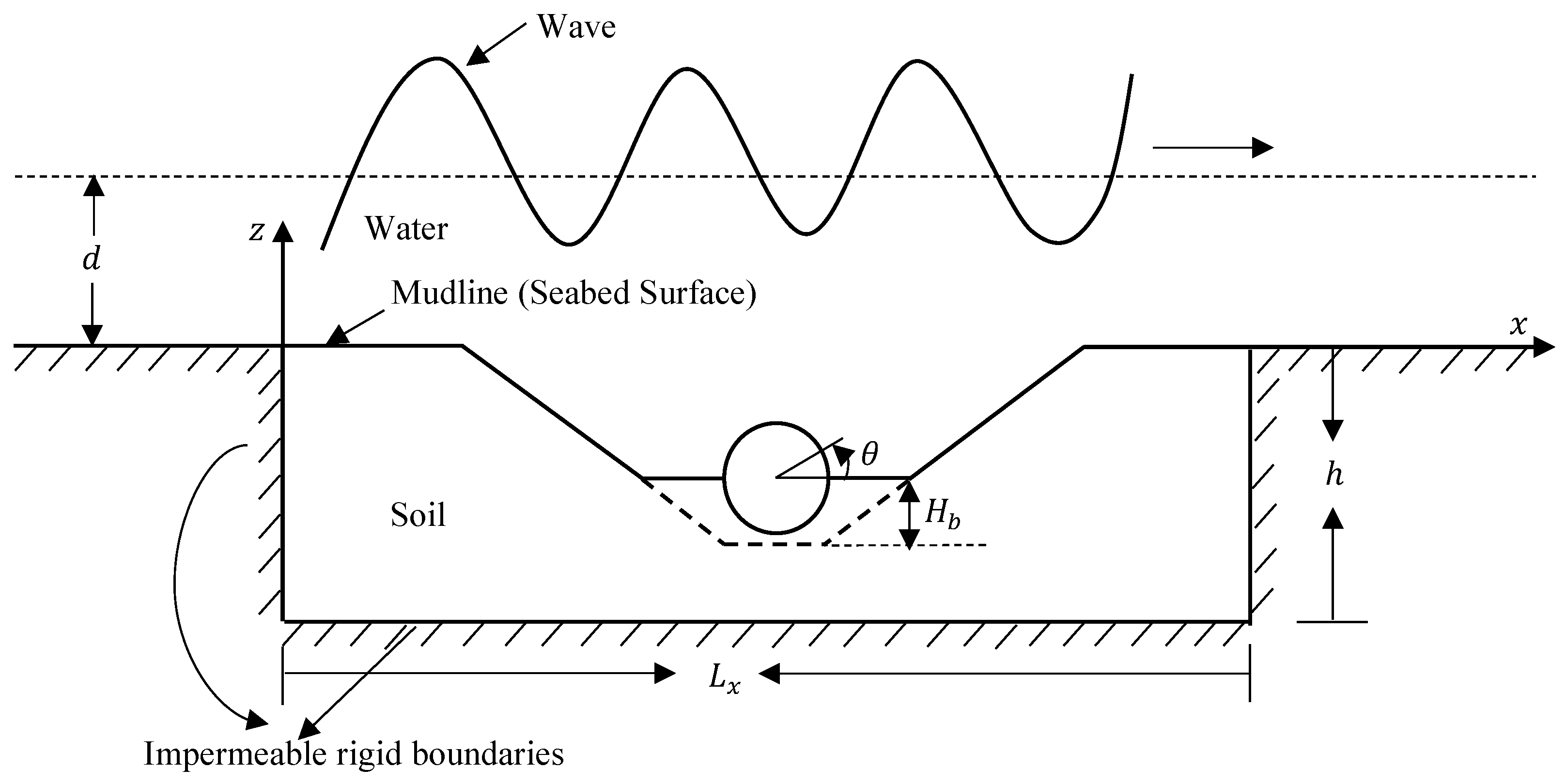
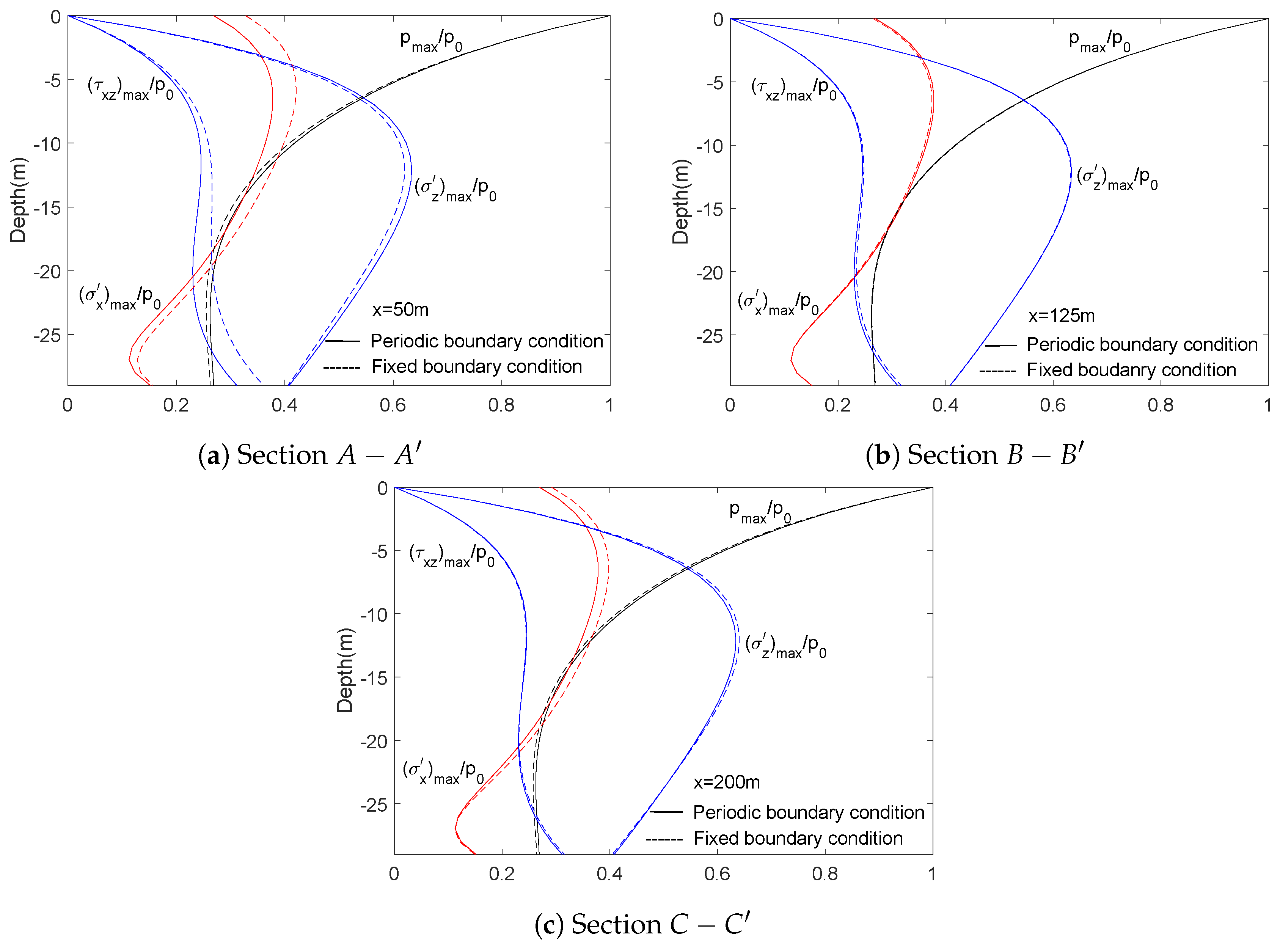
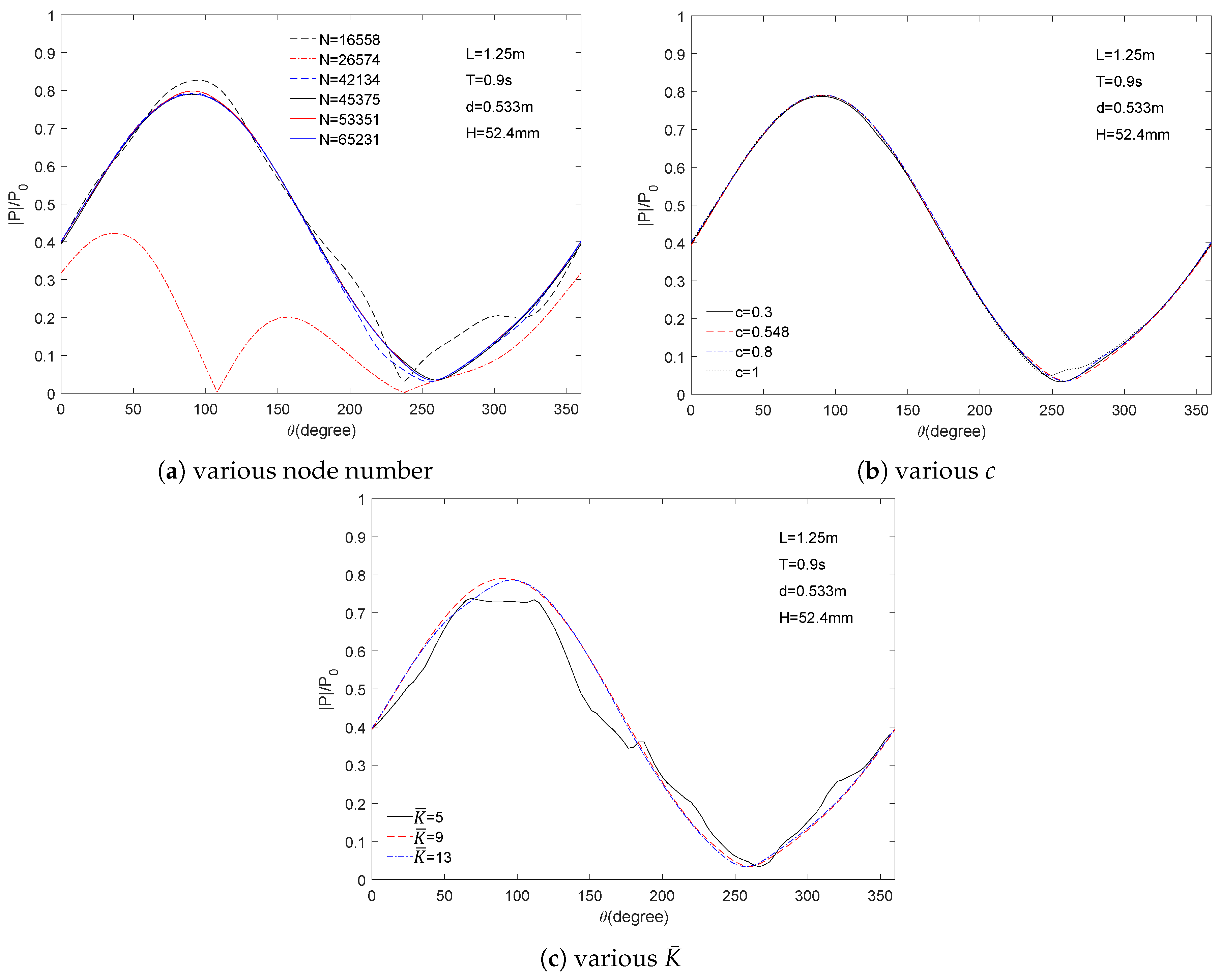
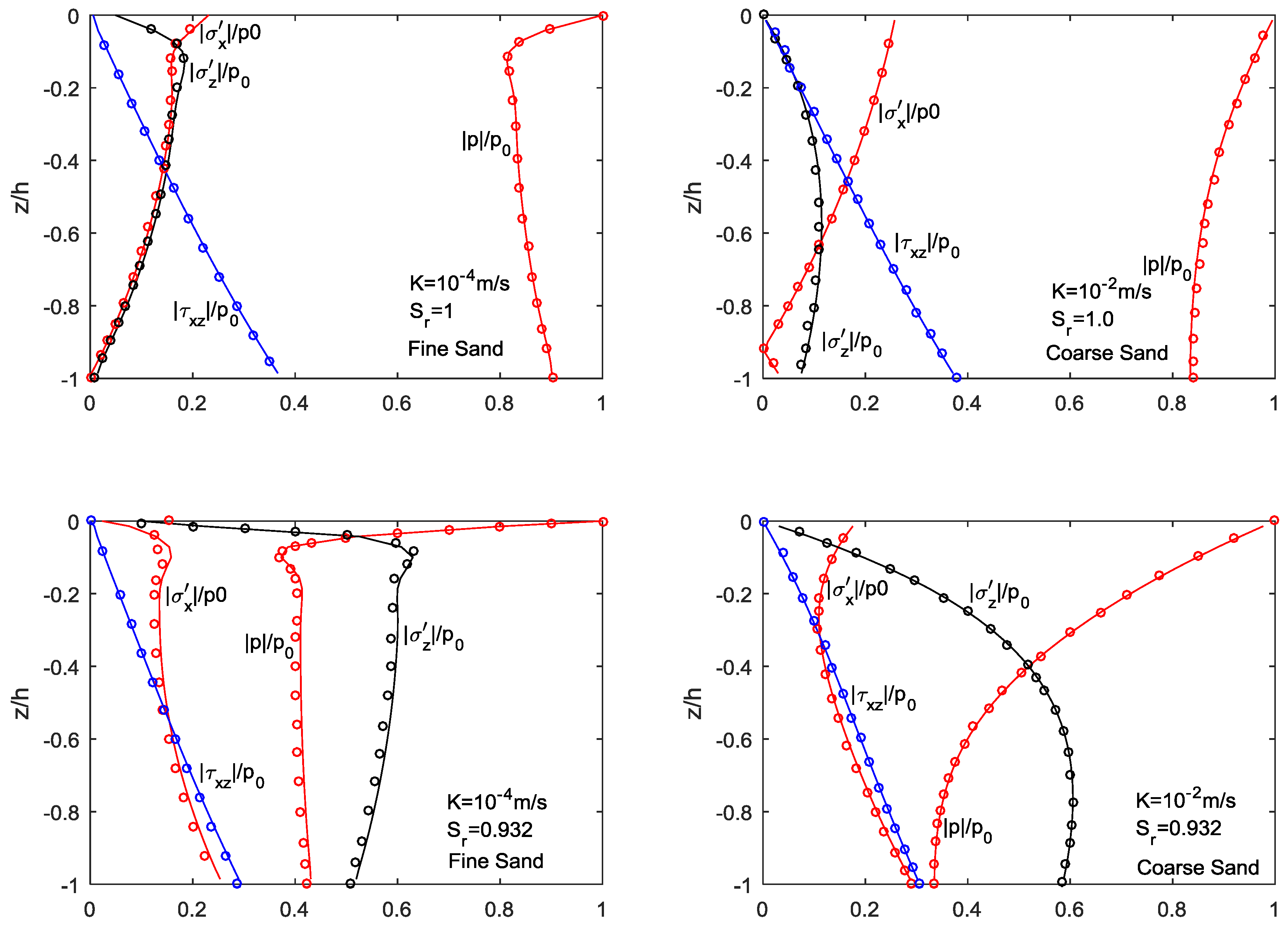
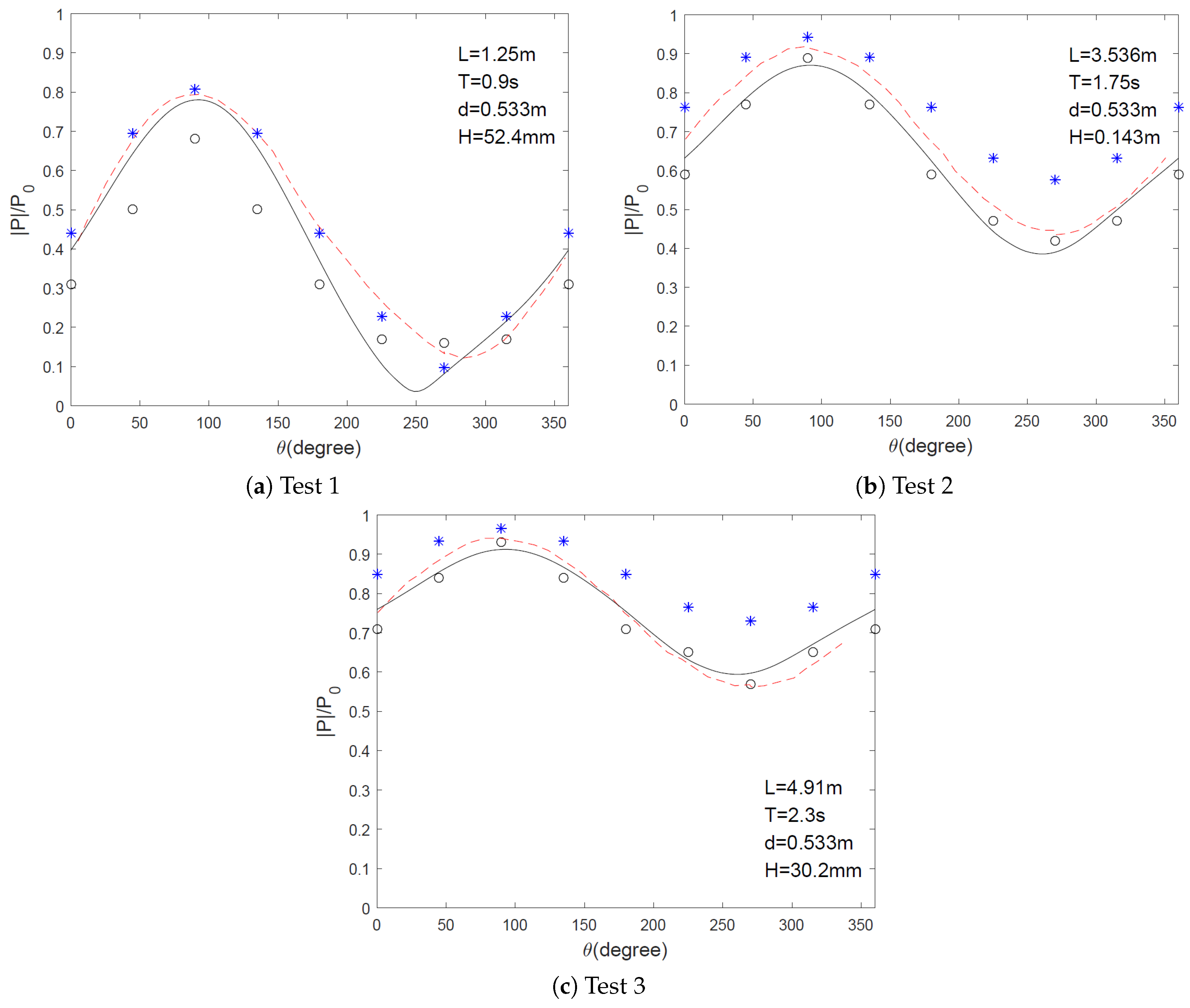
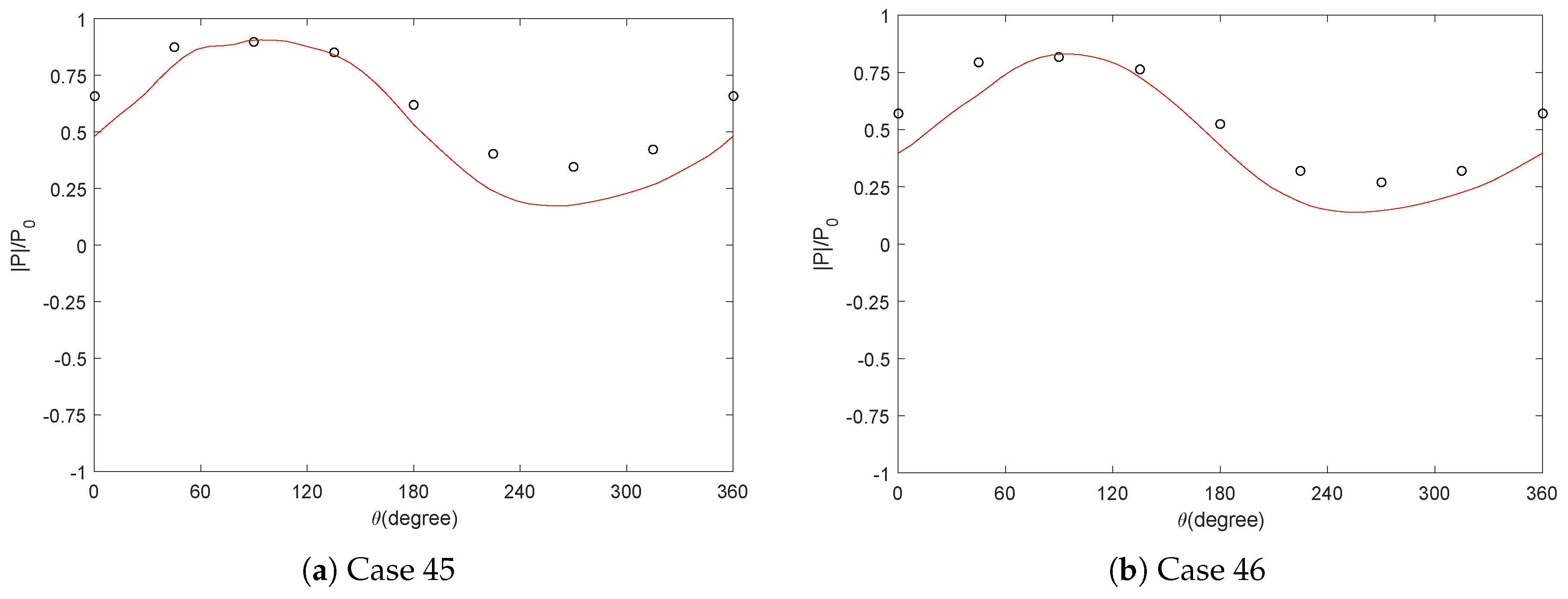

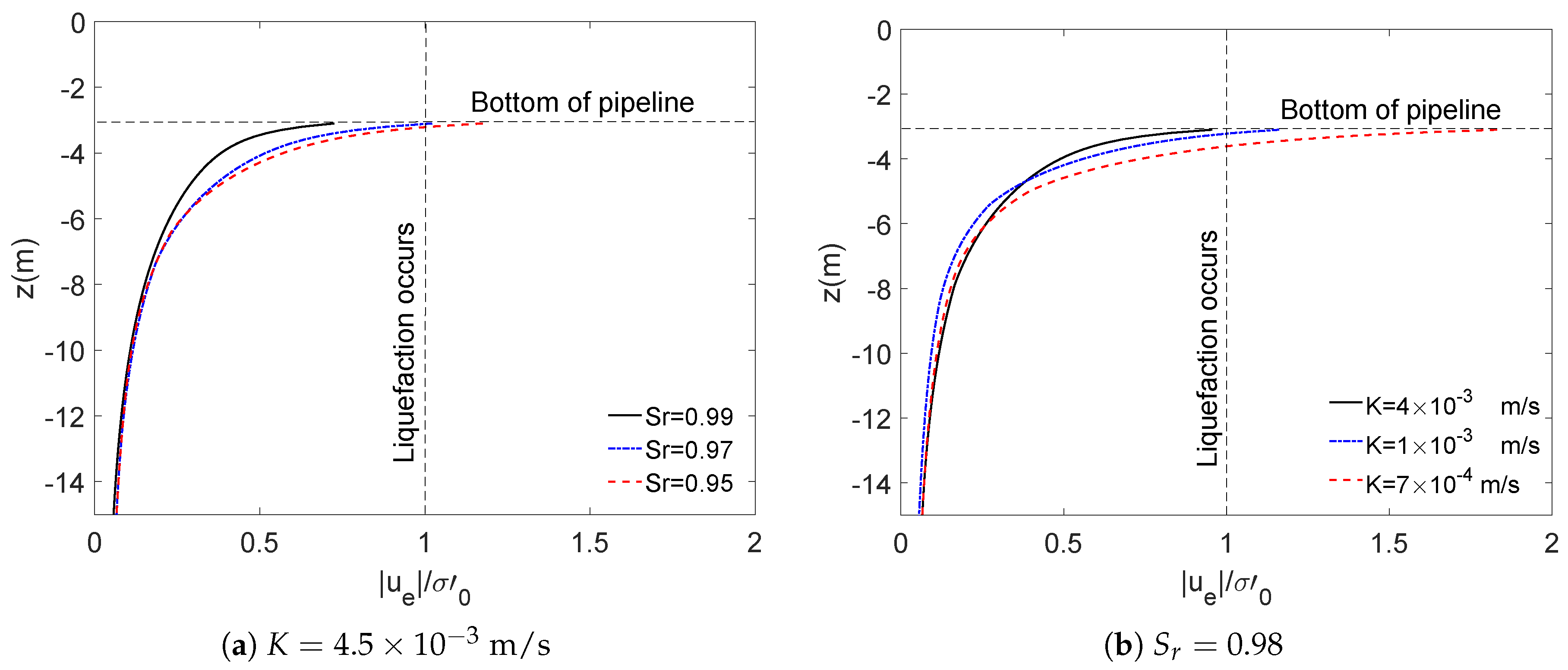

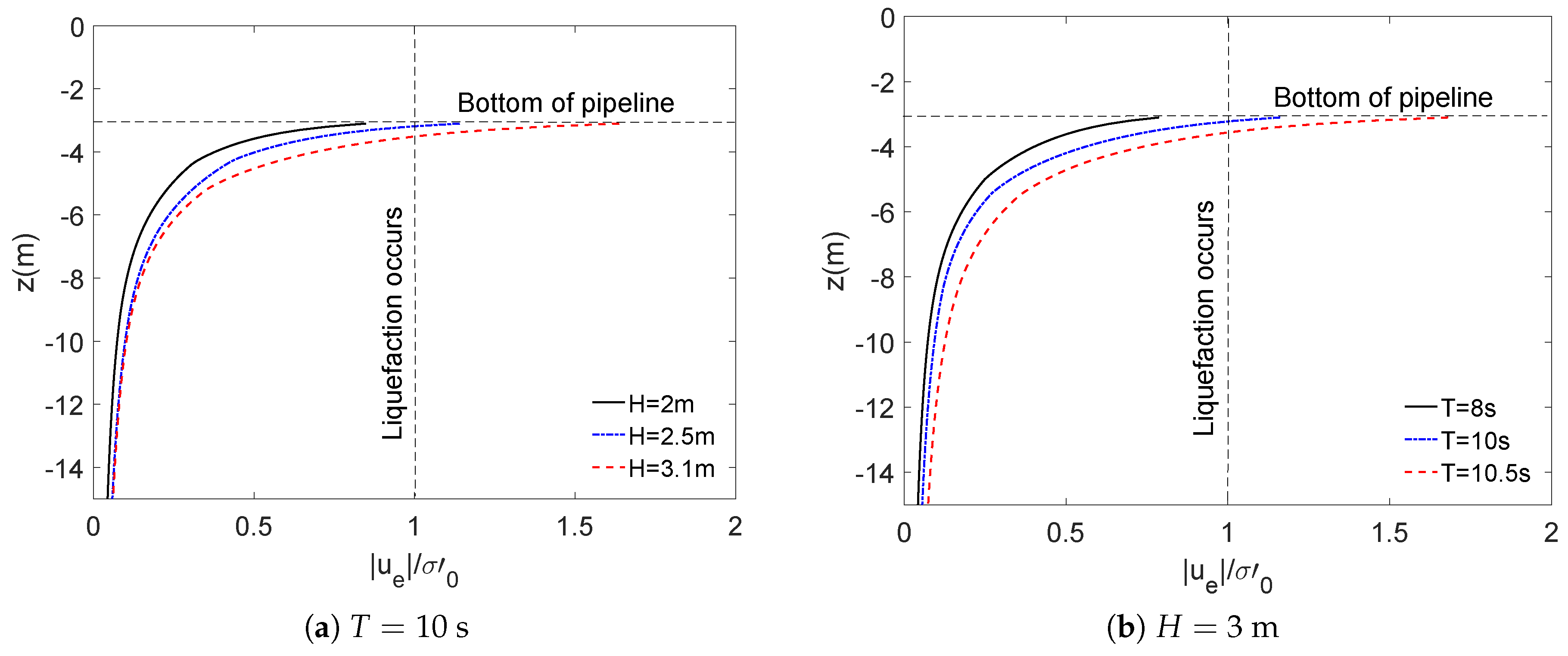

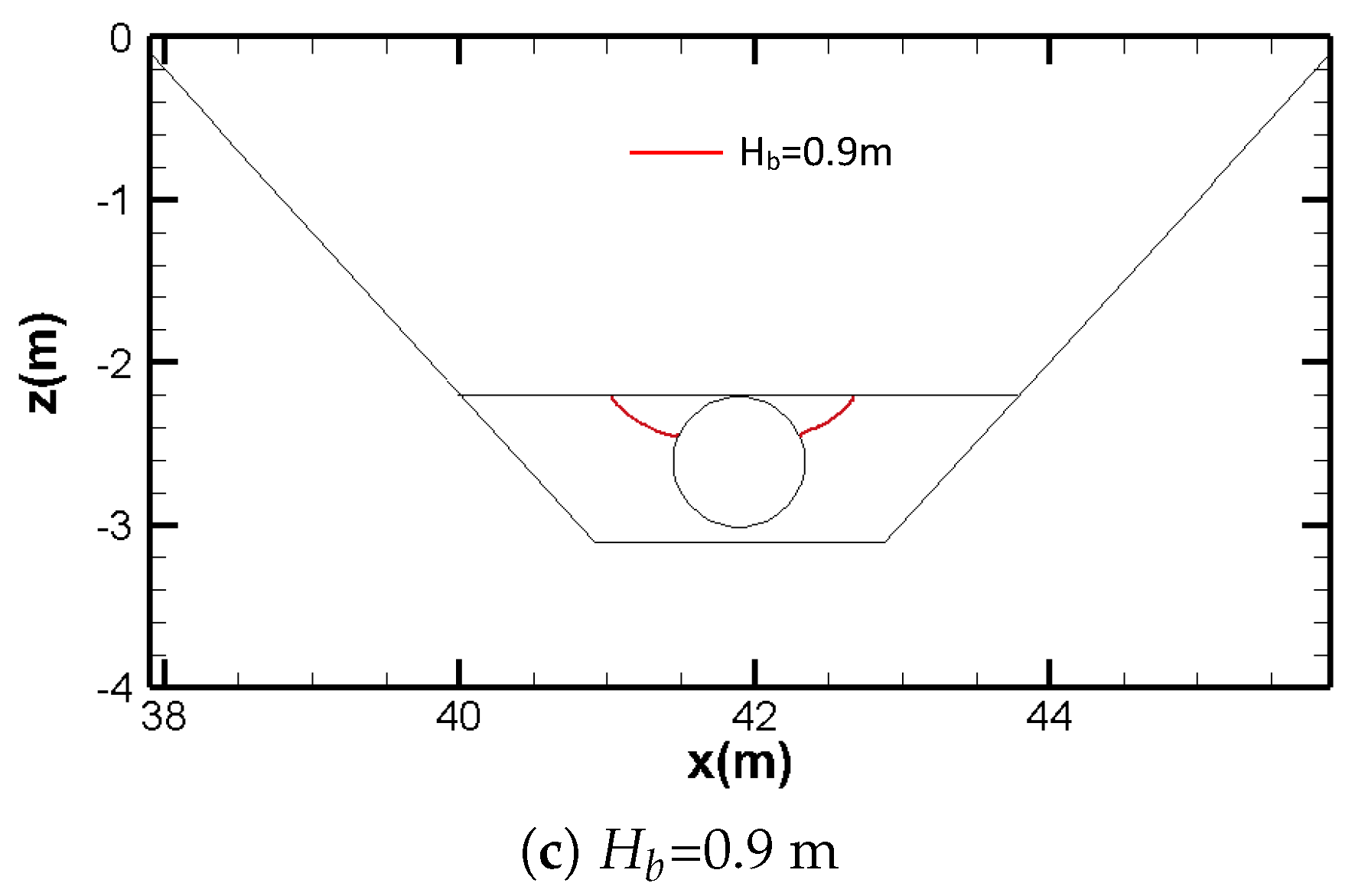

| Wave Characteristics | |
|---|---|
| Wave period | 8.0 s |
| Water depth | 20 m |
| Wave length | 88.88 m |
| Soil Characteristics | |
| Thickness of seabed | 30 m |
| Poisson’s ratio | 0.33333 |
| Soil porosity | 0.3 |
| Soil permeability | m/s |
| Degree of saturation | 0.98 |
| Shear modulus | N/m |
| Wave Characteristics | |
|---|---|
| Water depth | 0.4 m |
| Soil Characteristics | |
| Thickness of seabed | 0.58 m |
| Poisson’s ratio | 0.32 |
| Soil porosity | 0.396 |
| Soil permeability | m/s |
| Degree of saturation | 0.998 |
| Geometry of the Pipe | |
| Pipe radius | 0.05 m |
| Case No. | Wave Condition | Seabed Condition | ||
|---|---|---|---|---|
| Wave Height H (m) | Wave Period T (s) | Trench Depth (m) | Backfill Depth (m) | |
| 45 | 0.12 | 1.6 | 0.15 | 0.1 |
| 46 | 0.12 | 1.6 | 0.15 | 0.125 |
| Wave Characteristics | |
|---|---|
| Wave period | 10 s |
| Water depth | 8 m |
| Wave height | 3 m |
| Soil Characteristics | |
| Thickness of seabed | 30 m |
| Poisson’s ratio | 0.35 |
| Soil porosity | 0.425 |
| Soil permeability | m/s |
| Degree of saturation | 0.98 |
| Geometry of the Pipe | |
| Pipe radius | 0.4 m |
| Backfilled depth | 0.5 m |
© 2019 by the authors. Licensee MDPI, Basel, Switzerland. This article is an open access article distributed under the terms and conditions of the Creative Commons Attribution (CC BY) license (http://creativecommons.org/licenses/by/4.0/).
Share and Cite
Wang, X.X.; Jeng, D.-S.; Tsai, C.-C. Meshfree Model for Wave-Seabed Interactions Around Offshore Pipelines. J. Mar. Sci. Eng. 2019, 7, 87. https://doi.org/10.3390/jmse7040087
Wang XX, Jeng D-S, Tsai C-C. Meshfree Model for Wave-Seabed Interactions Around Offshore Pipelines. Journal of Marine Science and Engineering. 2019; 7(4):87. https://doi.org/10.3390/jmse7040087
Chicago/Turabian StyleWang, Xiao Xiao, Dong-Sheng Jeng, and Chia-Cheng Tsai. 2019. "Meshfree Model for Wave-Seabed Interactions Around Offshore Pipelines" Journal of Marine Science and Engineering 7, no. 4: 87. https://doi.org/10.3390/jmse7040087
APA StyleWang, X. X., Jeng, D.-S., & Tsai, C.-C. (2019). Meshfree Model for Wave-Seabed Interactions Around Offshore Pipelines. Journal of Marine Science and Engineering, 7(4), 87. https://doi.org/10.3390/jmse7040087







